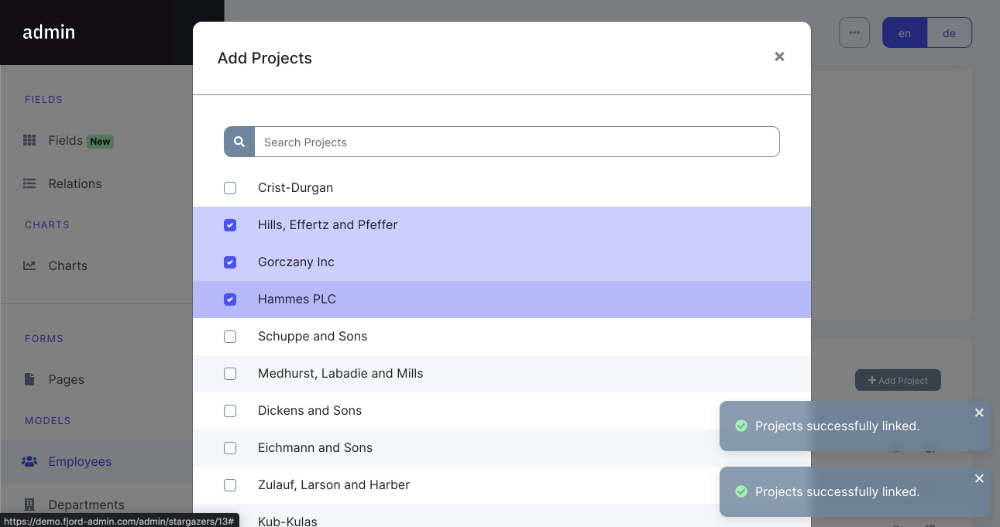Relation
- Introduction
- Preview
- Sortable
- Filter
- Forms
- Inline Fields
- Eager Loading & Appending Accessors
- Allow Direct Unlink
- Delete Unlinked Model
- Tags
- oneRelation And manyRelation
- Methods
Introduction
A relation picker. Relation pickers can be created for any relation of your model.

The relation field requires the name of the relation that should be edited. The type of the relation is automatically recognized and displayed accordingly.
The relations Field can only be used for Crud Models and not in Forms or Blocks. For Forms or Blocks the oneRelation or manyRelation field can be used.
$form->relation('articles')
->title('Articles')
->preview(function ($table) {
// Build the preview table in here.
$table->col('title'); // In this case we are showing the article title.
});;In the Model:
public function articles()
{
return $this->hasMany('App/Models/Article');
}Preview
The table preview is configured in preview.
$form->relation('articles')
->title('Articles')
->preview(function ($table) {
// Build the preview table in here.
$table->col('title'); // In this case we are showing the article title.
});However you don't need to define a new preview table every time you create a new
relation field. You can simply display the index table of the related Model by
setting settings its Crud config class in the use method list this:
use Lit\Config\Crud\ArticleConfig;
$form->relation('articles')
->title('Articles')
->use(ArticleConfig::class);Display Pivot Data
You may load and display data from the pivot table of a many to many relation.
In the following example we want to display when a subscrition of a user expires:
First load the pivot data by specifing the desired columns in the withPivot
method:
$index->query(function($query) {
$query->withPivot('expires_at');
});Now we can display the expires_at attribute like this:
$field->preview(function ($table) {
$table->col('subscriptions.pivot.expires_at');
});Sortable
If the relation should be sortable, the related query in your Model must be
sorted by an orderColumn.
public function articles()
{
return $this->hasMany('App/Models/Article')->orderBy('order_column');
}Now the sortable attribute can be added:
$form->relation('articles')
->title('Articles')
->sortable()
->preview(function ($table) {
$table->col('Title')->value('{title}');
});Filter
With a filter you can specify which models can be selected for a relation.
$form->relation('articles')
->title('Articles')
->filter(function($query) {
$query->where('created_by', lit_user()->id);
});Forms
You can edit the related attributes in a modal by configuring fields in the form method:
$form->relation('articles')
->form(function($form) {
$form->wysiwyg('text')->title('text');
});Create A New Relationship Model
You may also add a create form so the user can create new relationship models directly:
$form->relation('articles')
->create(function($form) {
$form->wysiwyg('text')->title('text');
});Set a create and edit form using the createAndUpdateForm.
Pivot Fields
Sometimes you may want to edit pivot data such as the expired_at date of a
subscription. Therefore the pivot method must be prepended to the field.
$field->form(function($form) {
$form->pivot()->datetime('expires_at')->title('Expires At');
});Inline Fields
You may even add inline fields to your relationship table. The following example show's how to add an relationship to opening hours that can be created and edited directly:

$form->relation('openingHours')
->title('Opening Hours')
->showTableHead()
->deleteUnlinked()
->hideRelationLink()
->names([
'singular' => 'Opening Hour',
'plural' => 'Opening Hours',
])
->preview(function ($preview) {
$preview->col('Week Day')->value('{week_day}');
$preview->field('Opening Time')
->datetime('opening_time')
->onlyTime()
->minuteInterval(15);
$preview->field('Closing Time')
->datetime('closing_time')
->onlyTime()
->minuteInterval(15);
})
->create(function ($form) {
$form->select('week_day')
->title('Wochentag')
->options([
'monday' => 'Monday',
'tuesday' => 'Tuesday',
'wednesday' => 'Wednesday',
'thursday' => 'Thursday',
'friday' => 'Friday',
'saturday' => 'Saturday',
'sunday' => 'Sunday',
]);
$form->datetime('opening_time')
->onlyTime()
->minuteInterval(15)
->width(1 / 2);
$form->datetime('closing_time')
->onlyTime()
->minuteInterval(15)
->width(1 / 2);
});Eager Loading & Appending Accessors
With query, relationships & accessors that should be displayed can be eager loaded or appended.
$form->relation('articles')
->title('Articles')
->query(function($query) {
$query->with('author')->append('comments_count');
})
->preview(function ($table) {
$table->col('Author')->value('{author.first_name} {author.last_name}');
$table->col('Comments')->value('{comments_count} comments');
});Allow Direct Unlink
To switch off the modal in which unlinking a relation is confirmed, confirm
must be set to false.
$form->relation('articles')
->confirm(false);Delete Unlinked Model
You may wish to delete a relation when it has been unlinked:
$form->relation('articles')
->deleteUnlinked();Tags
For many relations a tag preview can be generated by passing tags to the
type method. Therefore the attribute that should be displayed in the tag
must be specified using tagValue. Furthermore the variant can be specified
with tagVariant.
$form->relation('tags')
->title('Tags')
->type('tags')
->tagValue('{value}');
oneRelation And manyRelation
Every Laravel relation needs its corresponding database setup. For example the
belongsTo relation needs an extra column that stores the id of the related
Model. However you migth want to create relations without going through the
process of creating a new migration to add the required columns/tables. For this
there is the oneRelation and manyRelation. They can simply be added to your
Models or Forms.
The following example shows the simplep setup of a the relation field that works for both:
use App\Models\Article;
$form->manyRelation('articles')
->title('Articles')
->model(Article::class)
->preview(function($preview) {
//...
});In the Model:
public function articles()
{
return $this->manyRelation('App/Models/Article', 'articles');
}oneRelation and manyRelation can be used in Forms.
Methods
| Method | Description |
|---|---|
$field->title(') |
The title description for this field. |
$field->hint(') |
A short hint that should describe how to use the field.` |
$field->width() |
Width of the field. |
$field->filter() |
Initial query builder for the selectable relations. |
$field->query() |
Modify preview query with eager loads and accessors that should be displayed. |
$field->preview() |
A closure to define the table preview of the corresponding relation. |
$field->confirm() |
Modal pops when unlinkin the relation and asks to confirm. (default: true) |
$field->deleteUnlinked() |
Deletes the relation Model after unlinking the relation. (default: false) |
$field->sortable() |
Sortable relation (only works for many relations). |
$field->small() |
Small table column height. |
$field->maxItems() |
Set a maximum number of selectable items (only works for many relations). |
$field->create() |
Define form fields for a create form so users can crete new relationship models directly. |
$field->form() |
Define form fields so the user can update relation ship attributes. |
$field->createAndUpdateForm() |
Define the same form fields for create and form. |
$field->showTableHead() |
Whether the table head should be shown. (default: false) |
$field->type() |
The preview type (default: table) can be tags for many relations and link for one relations |
$field->tagValue() |
The attribute that should be displayed in the tag. |
$field->tagVariant() |
The bootstrap variant of the tag. (default: info) |
$field->linkValue() |
The attributes that should be displayed as the link. |